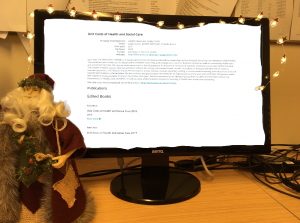December 5, 2019

By Lesley Curtis, Research Fellow at the PSSRU
With Christmas almost upon us, the finishing touches are being made to the latest edition of the Unit Costs of Health and Social Care (UCH&SC). Regular users will know that this publication is full of unit costs for several grades of health and social care professionals and we also commission guest editorials, short articles and unit costs drawn from research studies and secondary care datasets. Unit costs such as the cost of a GP visit or an hour of a nurse’s time are often used in cost-benefit and cost-effectiveness analyses. Those analyses need to use comprehensive and consistent unit costs to get the right decisions. Every year, we search for new cost studies which either enhance the work we already include or provide the basis for new schema. To whet your appetite for this latest volume, here is a brief preview of what to expect on December 16th (date to publish online) when I’m sure you will all be at your computer at midnight waiting to press the download button!
Our guest editorial t his year focuses on patient-level costing (PLICS) which will replace the NHS Reference Costs and can assist NHS provider organisations to deliver cost efficiencies and obtain value for money. This year, eight years after it was first introduced, Candice Goold of NHS Improvement, has outlined how patient-level costing is currently working in practice and can be used to make savings. In our 2020 edition, the UCH&SC unit costs for hospital care will be based on the PLICS data rather than reference costs.
his year focuses on patient-level costing (PLICS) which will replace the NHS Reference Costs and can assist NHS provider organisations to deliver cost efficiencies and obtain value for money. This year, eight years after it was first introduced, Candice Goold of NHS Improvement, has outlined how patient-level costing is currently working in practice and can be used to make savings. In our 2020 edition, the UCH&SC unit costs for hospital care will be based on the PLICS data rather than reference costs.
Our first short article has been commissioned in response to a consultation the Department of Health and Social Care carried out with analytical colleagues who prioritised the need for more research into the costs of sexual health services. James Moore and Paula Baraitser map the pathway for delivery of an online test for genital chlamydia, gonorrhoea, HIV and syphilis. This has produced a list of cost areas which should be considered.
In 2016, a plan for action was drawn up to reduce childhood obesity and our second article brings together cost information from three recent evaluations of interventions designed to either treat or prevent obesity in non-health settings. You can find all our previous articles and guest editorials written for the Unit Costs’ publication, in our online database.
New costs are found in:
- chapter 4: supported housing and specialised supported housing,
- chapter 3: a cost of face-to-face time is given for an alcohol health worker thanks to new research on how much time drug and alcohol workers spend with patients and
- chapter 1: multi-professional clinical medication reviews in care homes for older people and some care package costs in chapter 8 for people with suspected dementia.
Through analysing labour force survey data this year, we have been able to bring up to date our estimate of expected working life for social workers, nurses and medical practitioners. This has enabled us to calculate a more current estimate of the annual investment required for the initial training for professionals. Local authorities will be pleased to hear that the expected working life of a social worker has increased by 11 years since this work was last carried out in 2008, possibly as a result of councils encouraging and supporting experienced professionals back into employment. With a longer expected working life, annual costs are reduced; in this case from £25,417 in 2018 to £9,707 in 2019. A longer expected working life is also seen for nurses and Burtney and Buchanan’s report (2015) suggest reasons for why this might be the case. Not surprisingly, the data has also confirmed that medical practitioners are working fewer years and hence have higher annual costs than previously.
Finally, with thoughts turning to Christmas again, I am reminded of some research carried out on behalf of Age UK that shows that nearly a million older people feel lonelier at Christmas time. In the middle of all the festivities for some it is important to remember that this can be a difficult time for many people and we should all do our best to look out for those who do not find the season a joyful one. On a positive note, I was pleased to read that at the end of last year £11.5 million has been made available to tackle loneliness across England. Let’s hope it reaches some of those in most need.
Thanks to all the Unit Costs team once again for all their hard work; to Jennifer Beecham, Amanda Burns, Sarah Godfrey and Alan Dargan. Thanks also to contributors to this year’s volume. Merry Christmas!
This study/project is funded by the National Institute for Health Research (NIHR) [Policy Research Programme, Unit Costs of Health and Social Care, 035/0093.]. The views expressed are those of the authors and not necessarily those of the NIHR or the Department of Health and Social Care.
